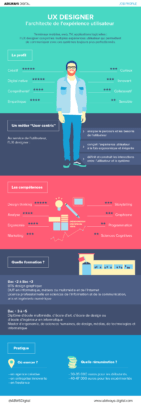Definition and importance of a job description
A job description is a document that describes in detail the duties, responsibilities, skills and qualifications required for a specific position within an organization.
It is an essential HR tool that serves as an official reference for potential candidates and current employees, clearly defining the company’s expectations for a given position.
For the company, a well-written job description facilitates the recruitment process by attracting qualified candidates for the position in question.
It also contributes to better internal organization by clarifying everyone’s roles and responsibilities, helping to improve productivity and efficiency.
For employees, the job description provides a clear understanding of what is expected of them in their job, which can increase job satisfaction and commitment.
It also serves as a basis for performance appraisals and career development.
A poorly written job description can lead to misunderstandings and unrealistic expectations, both for the company and for employees.
This in turn can lead to poor recruitment, job dissatisfaction and, ultimately, loss of productivity. turnover rate higher.
In addition, it can lead to internal conflict and lower productivity due to poor distribution of tasks and responsibilities.
The essential elements of a job description
For a job description to be effective, it must contain the following elements:
Job title : The job title must be clear and accurately reflect the position.
It must be specific enough to attract the ideal candidate profile.
The title is the element that is first visible and searched for by candidates on search engines, so don’t neglect it!
Department and hierarchy : This indicates the department to which the position is attached and the hierarchical position.
This helps to situate the position within the company’s overall organization.
- Job purpose This section should provide an overview of the position’s purpose and challenges, and its contribution to the organization.
- Missions, responsibilities and tasks : the main missions, responsibilities and specific tasks of the job must be detailed.
This should include both day-to-day activities and more strategic responsibilities.
Skills required (know-how and interpersonal skills): This involves listing the technical skills required for the position, as well as the interpersonal skills or soft skills that will be essential to success in this role.
Qualifications and experience required: It’s essential to indicate the academic and professional qualifications required, as well as the professional experience needed.
This can include diplomas, certifications, and years of experience in similar roles.
- Contact Interactions: this section describes the main interactions involved in the job.
Interlocutors may be internal or external to the company (suppliers, customers, service providers, etc.).
- Contact Interactions: this section describes the main interactions involved in the job.
Working conditions: To stand out from the competition, it’s important to give details of working conditions such as working hours, location, equipment and any specific conditions such as travel.
Career development and prospects: Indicating the career development opportunities associated with the position attracts ambitious and motivated candidates.
Steps to writing an effective job description
To write an effective job description, there are several steps to follow.
Gathering preliminary information
To begin with, you need to gather all the necessary information on the profile expected for the position and the job itself.
Talking to current employees in similar roles, as well as to line managers, will provide you with as much information as possible, directly from the field, so that you can draw up a relevant job description.
If several employees occupy similar positions, it’s a good idea to pool their experiences to enrich the job description.
Collaboration with line managers and HR
Once the information has been gathered, the job description should ideally be co-constructed with line managers and HR teams.
This ensures that all relevant information about the position is included, while meeting HR objectives for recruitment, internal mobility, etc.
Editorial staff
The job description must be clear, concise and comprehensible to a candidate from outside the organization.
Internal jargon and acronyms should be avoided.
The use of short sentences is recommended to facilitate reading.
Anyone reading the job description should be able to understand it quickly.
Readability is more important than completeness.
When describing tasks and missions, it’s best to use action verbs.
This makes the job description more dynamic and precise.
For example, instead of writing “responsible for management”, write “manage and supervise”.
Proofreading and validation
Having the document proofread and validated by line managers and HR ensures that it accurately reflects the expectations and profile of the position.
Example of a job description
To make sure you don’t forget anything, Boost’RH offers you a sample job description that can be used as a template to attract the ideal candidate.
- TARGET FUNCTION DEFINITION
| Function: Accounting ManagerReporting line: Director
|
| Updated by : XXUpdated by: XX | Validated by : XXDate : // |
| JOB PURPOSEDescribe the essential objective of the position, the expected result |
| Control of all the Mutual’s accounting activities and preparation of the annual balance sheet.Checks payment of Mutual Association benefits and contributions.Peripheral activities in personnel management, purchasing of equipment or services.Assistant management |
| MAIN MISSIONSDescribe the main tasks and responsibilities to meet the organization’s needs |
General accounting :
Cost accounting :
Treasury :
Annual review
Purchases of services
Property management
Personnel management
|
| MULTI-PURPOSE MISSIONSDescribe the functions or areas of intervention to replacing or assisting an employee |
| Partial replacement by the Accounting Assistant internally, externally, the CAC could fill her absence. A partial replacement for :
|
| CONTACTSSpecify the employee’s main contacts in the context of his or her position | |
| InternalThe whole team and the office | ExternalCACLawyerAsset managersSuppliers BankersMembers |
| AVAILABLE RESOURCES | |
| Human resourcesAn accounting assistant | EquipmentMicro-computer with office packAccounting softwareMutual insurance software |
| APPENDIXDefinition of roles |
Member and prospect relations:
Contract and membership management :
Contribution management :
Service management :
Third-party management :
Support functions :
|
Tips and best practices for optimizing job descriptions
For your job description to be truly effective, here are a few best practices to maximize its impact and clarity.
Using inclusive language
Using inclusive language helps to attract a wide range of candidates and promote diversity within the company.
This means writing gender-neutral sentences, avoiding stereotypical phrasing, and including expressions that show the company’s openness to all profiles.
For example, replace “he must” with “the person must”, and ensure that all skills are valued equally, without presuming the candidate’s gender.
Promoting corporate values
Company values need to be integrated into the job description, so that candidates can project themselves into the corporate culture.
This helps attract people whose values are in line with those of the organization.
For example, if the company values innovation and teamwork, it’s a good idea to mention this in the job description, explaining how these values translate into day-to-day business.
Adopt an attractive, easy-to-read format
The format of the job description should be both attractive and easy to read.
To achieve this, use clear headings and sub-headings, bulleted lists for required skills and main tasks, and short paragraphs.
A simple but effective design helps to hold the reader’s attention and get the essential information across quickly.

Example of an attractive job description in the form of an infographic.
Credit: Abilways-Digital
Regularly update job descriptions
Job descriptions must be regularly updated to ensure that they reflect the company’s current needs.
Job descriptions need to evolve with changes in organization, technology or market expectations.
An up-to-date job description also shows that the company is dynamic and in tune with its environment.
Examples of software and tools to get help
A number of tools can help you write and optimize your job descriptions.
Platforms such as Textio offers suggestions for inclusive and attractive language, while JobDescription.ai helps generate job descriptions based on predefined templates.
Human resources management tools such as Workday or BambooHR also include functions for creating and updating job descriptions, enabling this process to be centralized and automated.
You can also call on the services of a specialist to help you draw up your job descriptions. Outsourced HR who will share his experience to help you write effective job descriptions or update your existing ones.
Summary
In short, a well-written job description is essential to attracting the right candidates and ensuring effective skills management within the company.
By adopting simple, inclusive language, highlighting company values, and opting for a clear, readable format, you maximize the effectiveness of your job descriptions.
Don’t forget to update them regularly, so that they always reflect your organization’s current needs.
By applying these best practices, you’ll improve not only your recruitment processes, but also the satisfaction and commitment of your employees.

